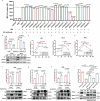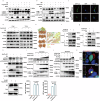Rab27a regulates the transport of influenza virus membrane proteins to the plasma membrane
- PMID: 40623997
- PMCID: PMC12234773
- DOI: 10.1038/s41467-025-61587-3
Rab27a regulates the transport of influenza virus membrane proteins to the plasma membrane
Abstract
The molecular mechanisms underlying the transport of influenza A virus (IAV) membrane proteins to the cell surface remain largely unclear. In this study, siRNA screening identifies Rab27a as a critical host factor regulating this transport process. GTP-bound Rab27a operates via its effectors, synaptotagmin-like protein 1 (SYTL1) and SYTL4, to facilitate the transport of vesicles carrying viral membrane proteins to the plasma membrane. Absence of Rab27a or SYTL4 does not block the early stages of the IAV life cycle but restricts viral assembly and budding. Notably, silencing SYTL4 provides superior protection in the female mouse IAV infection model. This investigation elucidates the molecular mechanism by which Rab27a and its effectors modulate the transport of IAV membrane proteins, thereby bridging a critical gap in IAV life cycle research and presenting a potential target for the development of antiviral drugs.
© 2025. The Author(s).
Conflict of interest statement
Competing interests: The authors declare no competing interests.
Figures







References
-
- Avilov, S. V., Moisy, D., Naffakh, N. & Cusack, S. Influenza A virus progeny vRNP trafficking in live infected cells studied with the virus-encoded fluorescently tagged PB2 protein. Vaccine30, 7411–7417 (2012). - PubMed
MeSH terms
Substances
Grants and funding
LinkOut - more resources
Full Text Sources
Research Materials
Miscellaneous

